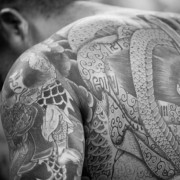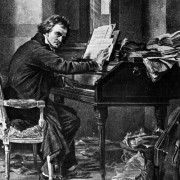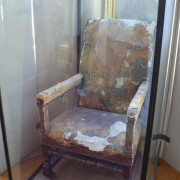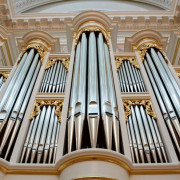Flugelhorn
Содержание:
Use and performances
The flugelhorn is a standard member of the British-style brass band, and it is also used frequently in jazz. It also appears occasionally in orchestral and concert band music. Famous orchestral works with flugelhorn include Igor Stravinsky’s Threni,Ralph Vaughan Williams’s Ninth Symphony, and Michael Tippett’s third symphony. The flugelhorn is sometimes substituted for the post horn in Mahler’s Third Symphony, and for the soprano Roman buccine in Ottorino Respighi’s Pines of Rome. In HK Gruber’s trumpet concerto Busking (2007) the soloist is directed to play a flugelhorn in the slow middle movement. The flugelhorn figured prominently in many of Burt Bacharach’s 1960s pop song arrangements. It is featured in a solo role in Bert Kaempfert’s 1962 recording of «That Happy Feeling». Flugelhorns have occasionally been used as the alto or low soprano voice in a drum and bugle corps.
Another use of the flugelhorn is found in the Dutch and Belgian «Fanfareorkesten» or fanfare orchestras. In these orchestras the flugelhorns, often between 10 and 20 in number, have a significant role, forming the base of the orchestra. They are pitched in B♭, with sporadically an E♭ soloist. Due to poor intonation these E♭ flugelhorns are mostly replaced by the E♭ trumpet or cornet.
The 1996 film Brassed Off features a flugelhorn performance of Rodrigo Concierto de Aranjuez, Adagio, as a key moment. The solo is played by Paul Hughes.
Use and performances
The flugelhorn is a standard member of the British-style brass band, and it is also used frequently in jazz. It also appears occasionally in orchestral and concert band music. Famous orchestral works with flugelhorn include Igor Stravinsky’s Threni,Ralph Vaughan Williams’s Ninth Symphony, and Michael Tippett’s third symphony. The flugelhorn is sometimes substituted for the post horn in Mahler’s Third Symphony, and for the soprano Roman buccine in Ottorino Respighi’s Pines of Rome. In HK Gruber’s trumpet concerto Busking (2007) the soloist is directed to play a flugelhorn in the slow middle movement. The flugelhorn figured prominently in many of Burt Bacharach’s 1960s pop song arrangements. It is featured in a solo role in Bert Kaempfert’s 1962 recording of «That Happy Feeling». Flugelhorns have occasionally been used as the alto or low soprano voice in a drum and bugle corps.
Another use of the flugelhorn is found in the Dutch and Belgian «Fanfareorkesten» or fanfare orchestras. In these orchestras the flugelhorns, often between 10 and 20 in number, have a significant role, forming the base of the orchestra. They are pitched in B♭, with sporadically an E♭ soloist. Due to poor intonation these E♭ flugelhorns are mostly replaced by the E♭ trumpet or cornet.
The 1996 film Brassed Off features a flugelhorn performance of Rodrigo Concierto de Aranjuez, Adagio, as a key moment. The solo is played by Paul Hughes.
Notable players
Joe Bishop, as a member of the Woody Herman band in 1936, was one of the earliest jazz musicians to use the flugelhorn. Shorty Rogers and Kenny Baker began playing it in the early fifties, and Clark Terry used it in Duke Ellington’s orchestra in the mid-1950s. Chet Baker recorded several albums on the instrument in the 1950s and 1960s. Miles Davis further popularized the instrument in jazz on the albums Miles Ahead and Sketches of Spain, (both arranged by Gil Evans) though he did not use it much on later projects. Other prominent flugelhorn players include Freddy Buzon, Freddie Hubbard, Tom Browne, Lee Morgan, Bill Dixon, Wilbur Harden, Art Farmer, Roy Hargrove, Randy Brecker, Hugh Masekela, Feya Faku, Tony Guerrero, Gary Lord, Jimmy Owens, Maynard Ferguson, Terumasa Hino, Woody Shaw, Guido Basso, Kenny Wheeler, Tom Harrell, Bill Coleman, Thad Jones, Arturo Sandoval, Lee Loughnane of the rock band Chicago, Mike Metheny, Harry Beckett, and Ack van Rooyen. Most jazz flugelhorn players use the instrument as an auxiliary to the trumpet, but in the 1970s Chuck Mangione gave up playing the trumpet and concentrated on the flugelhorn alone, notably on his jazz-pop hit song «Feels So Good». Mangione, in an interview on ABC during the 1980 Winter Olympics, for which he wrote the theme «Give It All You Got», referred to the flugelhorn as «the right baseball glove».[citation needed]
Pop flugelhorn players include Probyn Gregory (Brian Wilson Band), Ronnie Wilson of the Gap Band, Rick Braun, Mic Gillette, Jeff Oster, Zach Condon of the band Beirut, Scott Spillane of the band Neutral Milk Hotel, and Terry Kirkman of the band The Association. Marvin Stamm played the flugelhorn solo on «Uncle Albert/Admiral Halsey» by Paul and Linda McCartney.[citation needed]
Notable players
Joe Bishop, as a member of the Woody Herman band in 1936, was one of the earliest jazz musicians to use the flugelhorn. Shorty Rogers and Kenny Baker began playing it in the early fifties, and Clark Terry used it in Duke Ellington’s orchestra in the mid-1950s. Chet Baker recorded several albums on the instrument in the 1950s and 1960s. Miles Davis further popularized the instrument in jazz on the albums Miles Ahead and Sketches of Spain, (both arranged by Gil Evans) though he did not use it much on later projects. Other prominent flugelhorn players include Freddy Buzon, Freddie Hubbard, Tom Browne, Lee Morgan, Bill Dixon, Wilbur Harden, Art Farmer, Roy Hargrove, Randy Brecker, Hugh Masekela, Feya Faku, Tony Guerrero, Gary Lord, Jimmy Owens, Maynard Ferguson, Terumasa Hino, Woody Shaw, Guido Basso, Kenny Wheeler, Tom Harrell, Bill Coleman, Thad Jones, Arturo Sandoval, Lee Loughnane of the rock band Chicago, Mike Metheny, Harry Beckett, and Ack van Rooyen. Most jazz flugelhorn players use the instrument as an auxiliary to the trumpet, but in the 1970s Chuck Mangione gave up playing the trumpet and concentrated on the flugelhorn alone, notably on his jazz-pop hit song «Feels So Good». Mangione, in an interview on ABC during the 1980 Winter Olympics, for which he wrote the theme «Give It All You Got», referred to the flugelhorn as «the right baseball glove».[citation needed]
Pop flugelhorn players include Probyn Gregory (Brian Wilson Band), Ronnie Wilson of the Gap Band, Rick Braun, Mic Gillette, Jeff Oster, Zach Condon of the band Beirut, Scott Spillane of the band Neutral Milk Hotel, and Terry Kirkman of the band The Association. Marvin Stamm played the flugelhorn solo on «Uncle Albert/Admiral Halsey» by Paul and Linda McCartney.[citation needed]
Использовать
flugelhorn появляется, главным образом, в джазе, музыке духового оркестра и популярной музыке, хотя это иногда появляется в оркестровой музыке. Известные оркестровые работы с flugelhorn включают Threni Игоря Стравинского, Девятую Симфонию Ральфа Вона Уильямса, Danzon № 2 Артуро Маркесем и третья симфония Майкла Типпетта. flugelhorn иногда заменяют почтовый рожок в Третьей Симфонии Малера. На концерте трубы Грюбера HK, Облачающемся (2007), солист предписан играть flugelhorn в медленном среднем движении. flugelhorn фигурировал заметно во многих популярных мерах песни 1960-х Берта Бакары. Это показано в сольной роли в 1962 Берта Кэемпферта, делая запись Того Счастливого Чувства. Flugelhorns иногда использовались в качестве альта или низкого голоса сопрано в корпусе горна и барабане.
Structure and variants
A rotary valve flugelhorn
The flugelhorn is built in the same B♭ pitch as many trumpets and cornets. It usually has three piston valves and employs the same fingering system as other brass instruments, but four-piston valve and rotary valve variants also exist. It can thus be played without too much trouble by trumpet and cornet players, though some adaptation to their playing style may be needed. It is usually played with a more deeply conical mouthpiece than either trumpets or cornets (though not as conical as a French horn mouthpiece). The shank of the flugelhorn mouthpiece is similar in size to a cornet mouthpiece shank, and standard tapered flugelhorns are interchangeable with cornets.[citation needed]
Some modern flugelhorns feature a fourth valve that lowers the pitch a perfect fourth (similar to the fourth valve on some euphoniums, tubas, and piccolo trumpets, or the trigger on trombones). This adds a useful low range that, coupled with the flugelhorn’s dark sound, extends the instrument’s abilities. More often, however, players use the fourth valve in place of the first and third valve combination, which is somewhat sharp (compensated for on trumpets and cornets and some three-valve flugelhorns by an easily movable slide for the first or third valve).
A pair of bass flugelhorns in C, called fiscorns, are played in the Catalan cobla bands which provide music for sardana dancers.
Product Highlights
- Currently Popular
- New Products
- Top Sellers
- Trends
- Hot Deals
- Blow-Outs
7 B&S 3017/2TR-L Bb Flugelhorn £1,745 5 Thomann FH-1000S Flugelhorn £622 15 Carol Brass CFL-6200-GSS-Bb-L £949 8 Miraphone 24R 1100 A100 Flugelhorn £2,329 Hamaril Flugelhorn Set £332 1 Thomann FH-1000SL Flugelhorn £622 Miraphone 24R Edition Flugelhorn £3,699 Miraphone 25 1100 A100 Flugelhorn £2,522 4 Adams F2 GM Selected 055 170 BL £2,599 2 Adams F4 RM Selected 045 160 L £2,599 Miraphone 24R 1100A Flugelhorn £2,199 Miraphone 24R 1101 A100 Flugelhorn £3,444 2 Yamaha YFH-8315 G Flugelhorn £2,333 Schagerl Killerqueen «Z» Bb- Flugelhorn £4,444 2 C.G.Conn 1FR-SP Vintage One Flugelhorn £2,699 Bach 183S Flugelhorn £2,899 1 Peter Oberrauch Rosengarten Flgh 10,95 GP £3,444 1 Krinner Prinzessin Flugelhorn Gold £3,555 Yamaha YFH-8310 ZS Flugelhorn £2,399 Gerd Dowids BZ-Series GL91 RAW £2,890 Schagerl Dione Flugelhorn £2,777 Schagerl «AGLAEA» Bb- Flugelhorn £2,850 Schagerl James Morrison Flugelhorn £2,959 145 Thomann FH 600 G Bb-Flugelhorn £255 7 B&S 3017/2TR-L Bb Flugelhorn £1,745 55 Thomann FH-900J Raw JAZZ Bb-Flugelhorn £399 61 Thomann Black Jazz Bb- Flugelhorn £269 89 Thomann FH 600 Bb-Flugelhorn £215 13 Thomann TRF-23 Flugelhorn £399 5 Thomann TRF-56 Flugelhorn £589 8 B&S 17/2TR-L Bb-Flugelhorn £1,479 6 Yamaha YFH-8310 ZG Flugelhorn £2,299 39 Thomann FH-900 JSL JAZZ Bb-Flugelhorn £399 7 Jupiter JFH1100R Flugelhorn £799 7 Yamaha YFH-8310 ZGS Flugelhorn £2,399 3 Gerd Dowids BZ-Series Bb-Flugelhorn G88 £3,059 8 Miraphone 24R 1100 A100 Flugelhorn £2,329 9 Yamaha YFH-631 G Flugelhorn £1,690 2 Yamaha YFH-8315 GS Flugelhorn £2,399 2 Yamaha YFH-631 GS Flugelhorn £1,758 75 Thomann FH 600 GS Bb-Flugelhorn £299 2 Startone PFG-20 Bb- Flugelhorn Blue £142 2 Thomann FH-1000L Flugelhorn £579 13 Thomann TRF-23 Flugelhorn £399 Rank 456 B&S 3146/2-GL Brochon £1,890 Rank 38799 7 Yamaha YFH-8310 ZGS Flugelhorn £2,399 Rank 13612 89 Thomann FH 600 Bb-Flugelhorn £215 Rank 866 61 Thomann Black Jazz Bb- Flugelhorn £269 Rank 621 6 Yamaha YFH-8310 ZG Flugelhorn £2,299 Rank 17935 8 B&S 17/2TR-L Bb-Flugelhorn £1,479 Rank 6237 2 Yamaha YFH-631 GS Flugelhorn £1,758 Rank 31186 Adams Sonic Flugel Horn £1,599 Rank 17219 2 Yamaha YFH-8315 GS Flugelhorn £2,399 Rank 24823 1 B&S FBX-L X-Line £2,259 Rank 37841 Miraphone 24R 1100A Flugelhorn £2,199 Rank 80058 1 Melton MWF12T-L Flugelhorn £2,399 Rank 27763 Yamaha YFH-8310 ZS Flugelhorn £2,399 Rank 54912 6 B&S 3145-L Challenger I £1,333 Rank 43356 Miraphone 24R 1101 A100 Flugelhorn £3,444 Rank 79719 Miraphone 24R Edition Flugelhorn £3,699 Rank 76827 2 Adams F4 RM Selected 045 160 L £2,599 Rank 82923 1 Krinner Prinzessin Flugelhorn Gold £3,555 Rank 86493 1 Adams F2 GM Custom 055 170 SL £2,699 Rank 38719 145 Thomann FH 600 G Bb-Flugelhorn £255 13 Thomann TRF-23 Flugelhorn £399 61 Thomann Black Jazz Bb- Flugelhorn £269 89 Thomann FH 600 Bb-Flugelhorn £215 Thomann FH-900 JSL JAZZ Bb-Flu B-Stock £289 27 Thomann FH 600 G Bb-Flugelhorn B-Stock £231 Adams F2 GM Selected 055 170 B-Stock £2,222
Известные игроки
Джо Бишоп, как член группы Вуди Хермана в 1936, был одним из самых ранних джазовых музыкантов, чтобы использовать flugelhorn. Коротышка Роджерс и Кенни Бейкер начали играть его в начале пятидесятых, и Кларк Терри использовал его в оркестре Дюка Эллингтона в середине 1950-х. Чет Бейкер записал несколько альбомов на инструменте в 1950-х и 1960-х. Майлз Дэвис далее популяризировал инструмент в джазе на альбомах Майлз Ахэд и Эскизы Испании, (оба устроенные Джилом Эвансом), хотя он не использовал его очень на более поздних проектах. Другой видный джаз flugelhorn игроки включает Фредди Хаббарда, Тома Брауна, Ли Моргана, Фермера Искусства, Роя Харгроува, Хью Мэзекелу, Feya Faku, Тони Герреро, Джимми Оуэнса, Мэйнарда Фергюсона, Terumasa Hino, Вуди Шоу, Гидо Бассо, Кенни Уилера, Тома Харрелла, Билла Коулмана, Тэда Джонса, Артуро Сандовала, Ли Лонэйна рок-группы Чикаго, Майка Метэни и Гарри Беккета. Большая часть джаза flugelhorn игроки использует инструмент в качестве вспомогательного глагола к трубе, но в 1970-х Чак Манджион бросил играть на трубе и сконцентрировался на flugelhorn один, особенно на «Чувствует себя Так Хорошо». Манджион, в интервью во время телевизионной передачи Олимпийских Игр на ABC, для которой он написал тему, «Дает Все это, Вы Добрались», упомянул flugelhorn как «… правильная бейсбольная перчатка».
Трещите среди flugelhorn игроков Пробин Грегори (Группа Брайана Уилсона), Рик Браун, Мик Джиллет, Джефф Остер и Зак Кондон Бейрута. Другой известный игрок — Скотт Спиллэйн американской инди-рок группы Neutral Milk Hotel.
Structure and variants
A rotary valve flugelhorn
The flugelhorn is built in the same B♭ pitch as many trumpets and cornets. It usually has three piston valves and employs the same fingering system as other brass instruments, but four-piston valve and rotary valve variants also exist. It can thus be played without too much trouble by trumpet and cornet players, though some adaptation to their playing style may be needed. It is usually played with a more deeply conical mouthpiece than either trumpets or cornets (though not as conical as a French horn mouthpiece). The shank of the flugelhorn mouthpiece is similar in size to a cornet mouthpiece shank, and standard tapered flugelhorns are interchangeable with cornets.[citation needed]
Some modern flugelhorns feature a fourth valve that lowers the pitch a perfect fourth (similar to the fourth valve on some euphoniums, tubas, and piccolo trumpets, or the trigger on trombones). This adds a useful low range that, coupled with the flugelhorn’s dark sound, extends the instrument’s abilities. More often, however, players use the fourth valve in place of the first and third valve combination, which is somewhat sharp (compensated for on trumpets and cornets and some three-valve flugelhorns by an easily movable slide for the first or third valve).
A pair of bass flugelhorns in C, called fiscorns, are played in the Catalan cobla bands which provide music for sardana dancers.
Структура и варианты
flugelhorn построен в той же самой подаче B как много труб и корнетов. Это обычно имеет три поршневых клапана и использует тот же самый перебирающий систему как другие медные инструменты, но клапан с четырьмя поршнями и ротационные варианты клапана также существуют. Это может таким образом играться без слишком большой проблемы трубой и игроками корнета, хотя некоторая адаптация к их стилю игры может быть необходима. Это обычно играется с более очень коническим мундштуком или, чем трубы или, чем корнеты (хотя не столь конический как роговой мундштук).
Некоторые современные flugelhorns показывают четвертый клапан, который понижает подачу прекрасная четверть (подобный четвертому клапану на некоторых эуфониумах, тубах, и трубах малой флейты или спусковом механизме на тромбонах). Это добавляет полезный низкий диапазон, который, вместе с темным звуком flugelhorn, расширяет способности инструмента. Чаще, однако, игроки используют четвертый клапан вместо первой и третьей комбинации клапана, которая несколько остра (дал компенсацию за на трубах и корнетах и некотором flugelhorns с тремя клапанами понижением для первого или третьего клапана).
Пара баса flugelhorns в C, названном fiscorns, играется в каталонских группах плоскодонной рыбачьей лодки, которые предоставляют музыку танцорам сарданы.








